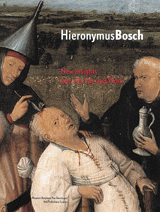
Jacobs 2001
“The Triptych Unhinged: Bosch’s Garden of Earthly Delights” (Lynn F. Jacobs) 2001
[in: Jos Koldeweij, Bernard Vermet and Barbera van Kooij (eds.), Hieronymus Bosch. New Insights Into His Life and Work. Museum Boijmans Van Beuningen-NAi Publishers-Ludion, Rotterdam, 2001, pp. 64-75]
The Garden of Delights is a key work when it comes down to understanding Bosch’s inventive handling of the traditions of the Netherlandish triptych format. A full history of the triptych has yet to be written but it is clear that Bosch was very conscious of the implications of the triptych format, perhaps even more so than other late medieval painters. The Garden of Delights can be seen as a key example of the disintegration of the triptych format around 1500, because the three essential characteristics of the fifteenth-century triptych are absent in this painting: a focus on religious subject matter, an emphasis on the centre of the interior and an additive (rather than unified) conception of the whole.
Bosch’s triptych deals with secular, even sexual subjects (especially on the central panel) within a format that was traditionally reserved for religious themes. There was some tradition of profane triptychs (sometimes also with erotic motifs) but without exception these were rather small, whereas the Garden of Delights is monumental. And yet the wings of the Garden create a religious and moralizing context, making clear that the carnal activities on the central panel have to be associated with the sin of lust. Also in other triptychs, such as the Haywain (Madrid) and the Temptations of St. Anthony (Lisbon) Bosch introduced secular images, shifting the focus to a moral invective against man and his activities in the world. Bosch’s moralizing criticism is analogous to the moralizing humanistic literature of his day. Most likely the Garden of Delights was not meant to be an altarpiece but it had another, more secular function, to be compared with the function of the medieval mappaemundi (circular world maps).
A striking novelty of Bosch’s triptych is the unusual emphasis on the closed wings, creating an equality between the interior and the exterior. This emphasis is established in three ways. First Bosch includes touches of colour within the grisaille, thus breaking down the standard distinction between monochrome exteriors and polychrome interiors. Secondly the narrative content of the exterior is as important as that of the interior: the third day of creation is parallel with rather than subordinate to the other moments of creation which are shown on the interior. And thirdly the closed wings receive a stronger visual expressivity thanks to the use of a circular form that continues across both exterior panels. Apparently the use of the roundel format was a unique characteristic of Bosch’s triptychs.
Traditionally fifteenth-century triptychs were conceived in an additive fashion, with each panel quite separated from the others and connected only in limited ways. With Bosch the interior and exterior panels formed a coherent iconographical unity. Together the closed wings of the Garden of Delights create one image (something that can also be noticed with other painters in the early sixteenth century) and on the three interior panels the horizon lines are linked to form one continuous landscape setting. Moreover the interior panels are linked together by the theme of procreation: at left the Marriage of Adam and Eve (instead of the more traditional Fall of Man), in the middle Adam and Eve’s descendants after the Fall with sexual activities and fertility symbols and at right Hell and mortality (a consequence of the Fall which necessitated procreation). On the other hand each panel represents a different moment in time, which is suggested on the interior by the shifting use of colours on the central panel and the right wing. The closed wings also represent two phases: at the right the very first beginnings with a lot of shadow and at the left the sprouting of trees and fruits with more light.
In the Garden of Delights the triptych format contributes on a number of levels to the meaning of the work. This implies an innovative self-consciousness of the artist Bosch, so distinctive of the sixteenth century.
In this contribution Jacobs offers some interesting and alert observations on Bosch’s innovating use of the triptych format, although sometimes she seems to be exaggerating a little bit (for example when she writes about the equality between the exterior and interior panels). Her iconographic remarks on the interior panels of the Garden of Delights are not always convincing either. The content of this contribution is largely the same as the content of a magazine article Jacobs wrote somewhat earlier (see Jacobs 2000).
[explicit]